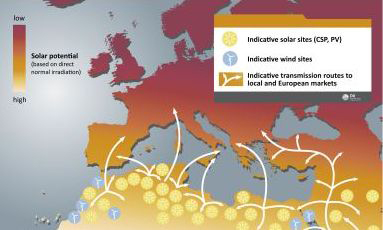Clean electricity from deserts will soon be making a growing contribution to supplying the people of North Africa and the Middle East with power. And electricity from solar and wind plants in the desert will also find its way to Europe within the space of the next decade. In doing so, it will help all 27 EU states achieve their ambitious renewable energy goals by the year 2020.
"Based on a foundation of mutual respect, partnership and cooperation, a new age of sustainable energy supply can begin that is to the benefit of all. We now want to show how the Desertec vision of electricity for North Africa, the Middle East and Europe from renewable energy sources can be turned into very real activities and projects through this collaboration," said Dii CEO Paul van Son today at the first annual Dii conference in Barcelona.

Around 300 participants from the Arab nations and Europe are using this conference today and tomorrow to take stock of the progress being made on the topic of electricity from the desert. The presence of government and corporate representatives from potential electricity-generating countries such as Morocco, Algeria, Tunisia, Libya and Egypt bears witness to the great interest that North Africa has in renewable energies. Opened by EU Commissioner for Energy Günther Oettinger, the conference will address all the important aspects of the Desertec vision: - Generating energy in deserts: At which locations in desert regions can energy be generated using sun and wind, with which technology and at what cost? These are the key questions in the field of power generation that international experts from the commercial and
research sectors are discussing. On the basis of geo-scientific analysis, the possible locations have to be found and the best suited technologies identified, such as solar thermal and photovoltaic, and the expected generation costs calculated. The ways of reducing energy production costs are also an important consideration here. - Transporting electricity to local and distant consumption centres: There are also many technical and economic aspects that have to be clarified when it comes to how to transport the electricity from the generation locations to the places where consumers need it. Existing electricity grids have to be examined as to their suitability for the future, bottlenecks have to be identified and the best possible transmission technologies selected. Within the scope of its work, Dii will also submit scenarios for the structure of the electricity grids
by 2012, and the related investment propositions. In doing so, the close collaboration between Dii und MEDGRID/Transgreen will be of
particular importance. This international industrial consortium is to be founded in Paris in November and develop an integrated master plan in the framework of the Mediterranean Solar Plan for a high-performance electricity grid in the Mediterranean. Using this grid, the plan is then to be able to transport up to five gigawatts from Africa to Europe. - The development of the energy markets: In the focus of the market analysis is the question of how the gap between the costs of
electricity from the desert and the income that can be expected from it can be bridged over time. The analysis of the market potential is as important here as is the issue of who comes into question as a future buyer of the electricity. In order to make desert electricity
marketable in the medium term, stimulation mechanisms have to be investigated and compared. In particular, a standardised pan-European feed-in tariff for North African solar and wind energy would be an important tool here. The earnings that can be achieved in Europe - for solar energy, for example - could also be used as financing levers for more investments in North Africa. - Economic and social development potential for the MENA region: A crucial success factor for the realisation of the Desertec vision will
also be the analysis and ascertainment of the benefit that the potential producers of the energy from the desert will gain. To this
end, the macro-economic effects of the expected investments have to be identified. The value created locally by Desertec has to become visible - for example, through the development of industries, the creation of jobs and the transfer of know-how. - Political-regulatory environment: The political-regulatory environment is another key factor for the realisation of the Desertec vision. The EU directive on the promotion of the use of energy from renewable sources provides the legal foundation for the integration of electricity from the desert. This directive makes it possible to import renewable electricity from non-EU states as long as it is then consumed within the EU. "The EU directive for the promotion of renewable energies is an important regulatory lever for decisively advancing the vision of electricity from the desert," says Paul van Son, CEO of the industry initiative Dii.
MOST POPULAR IN LAST 24 HRS
MOST POPULAR IN LAST 7 DAYS
|